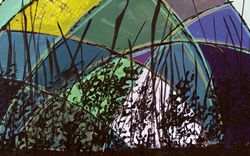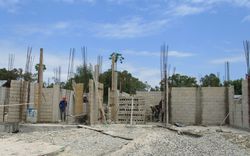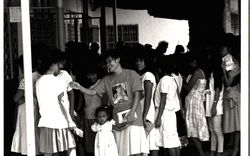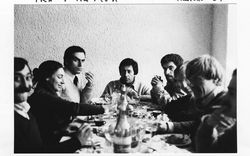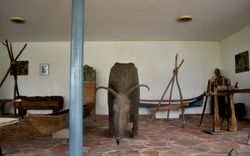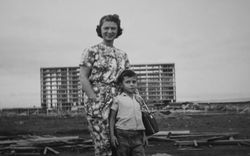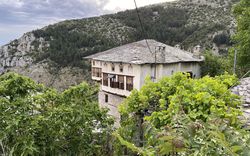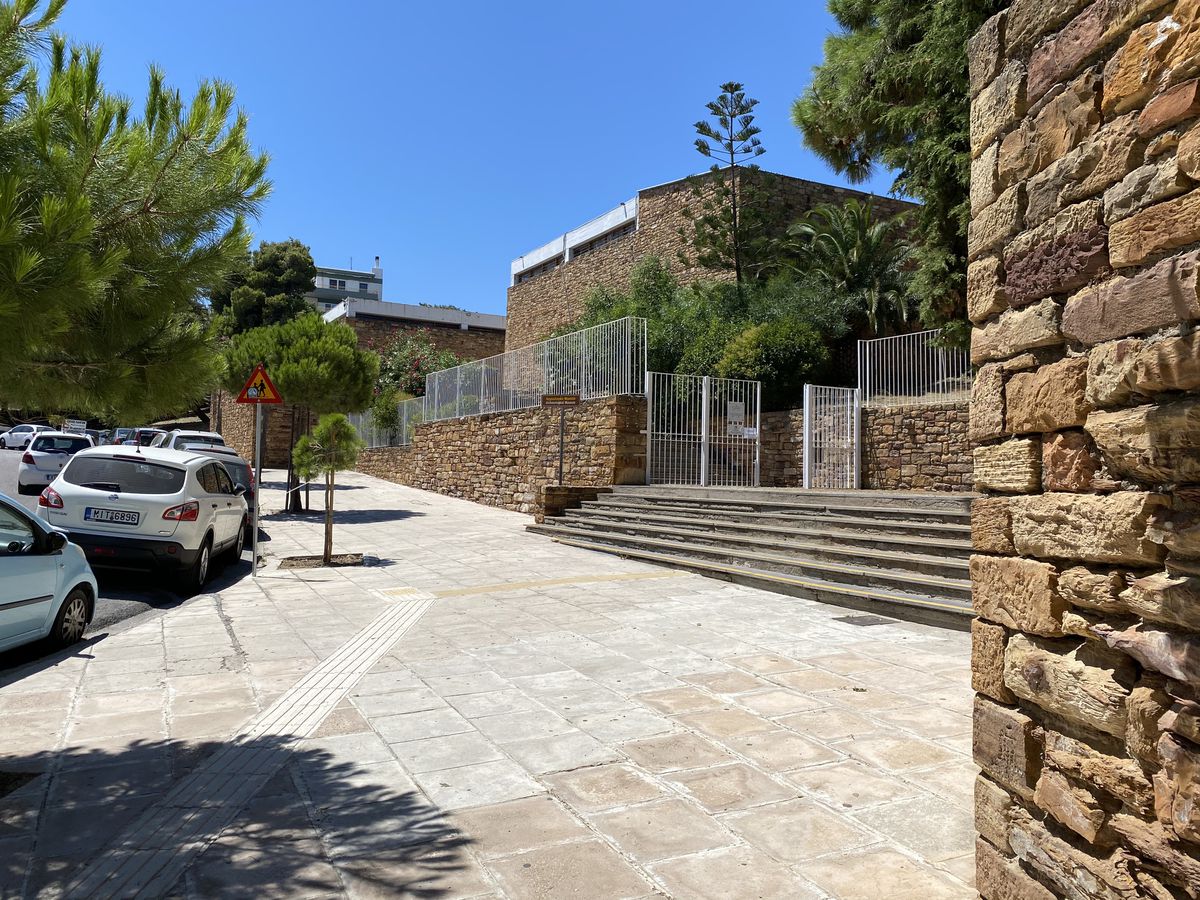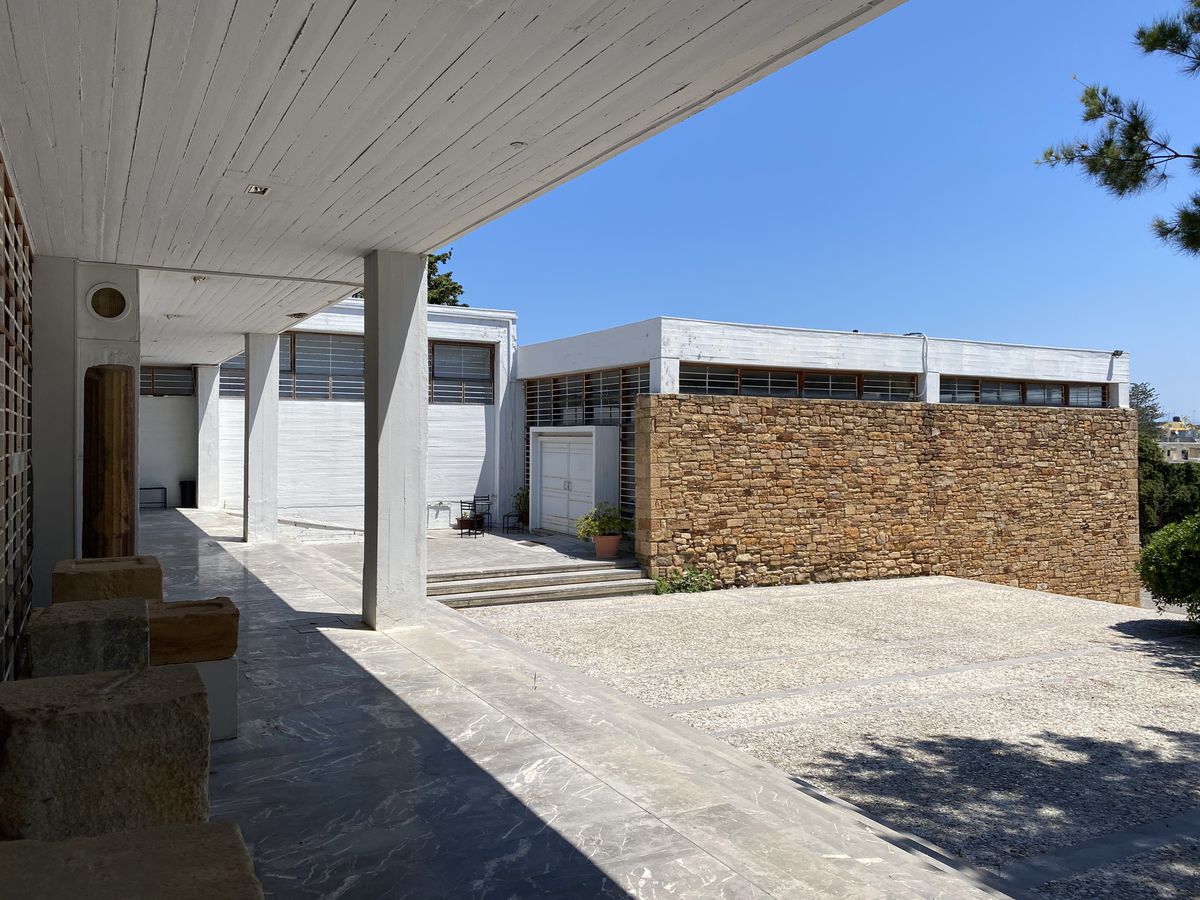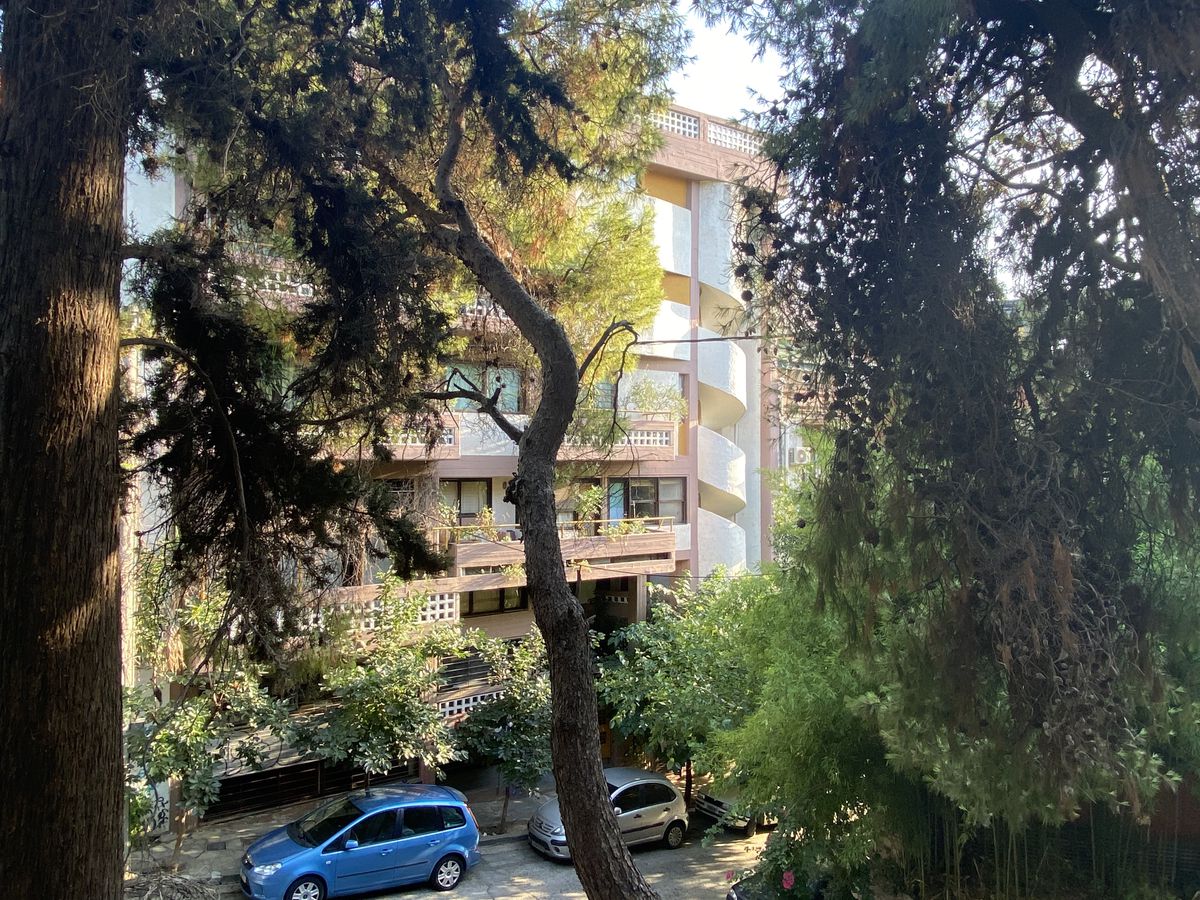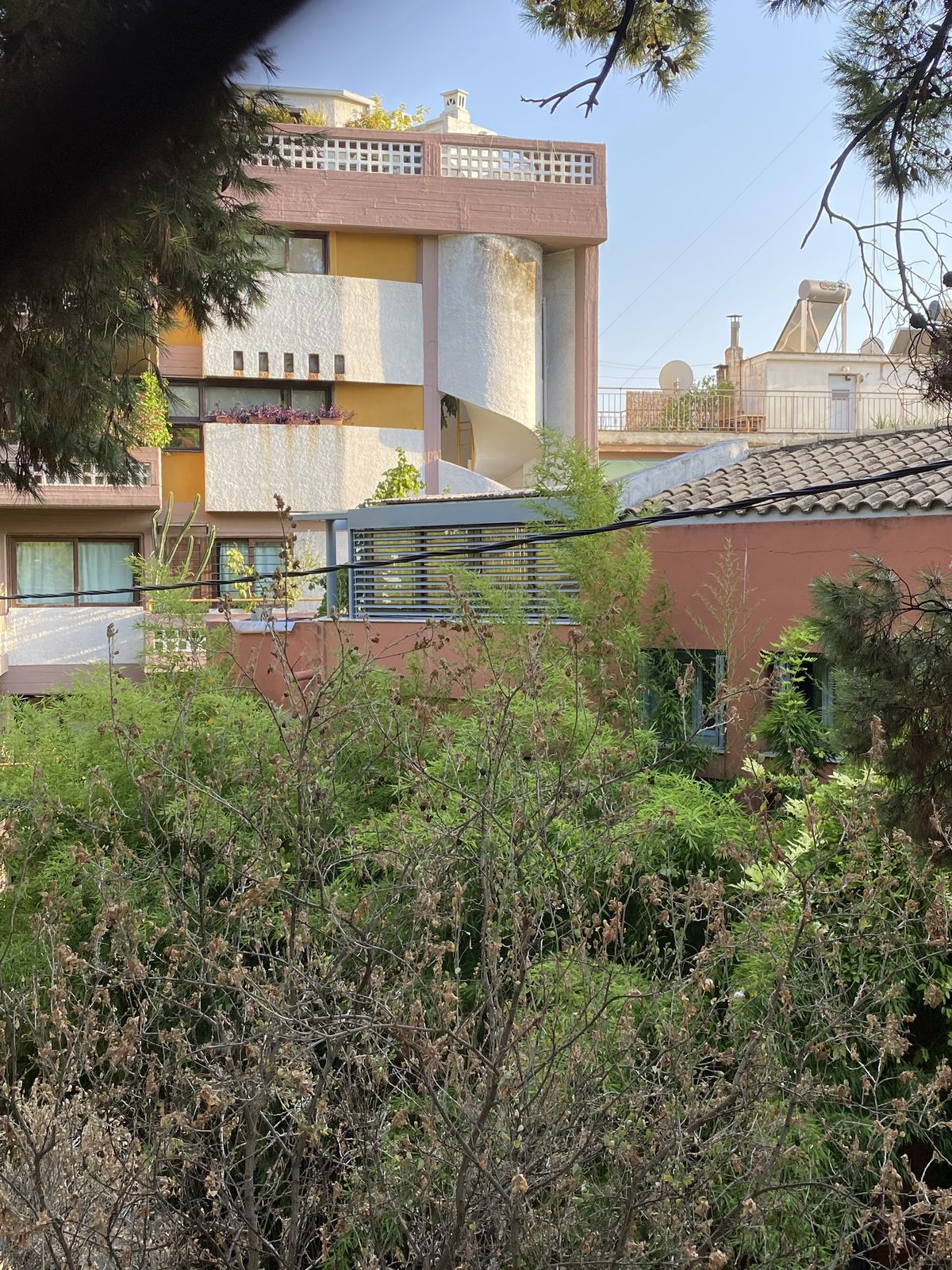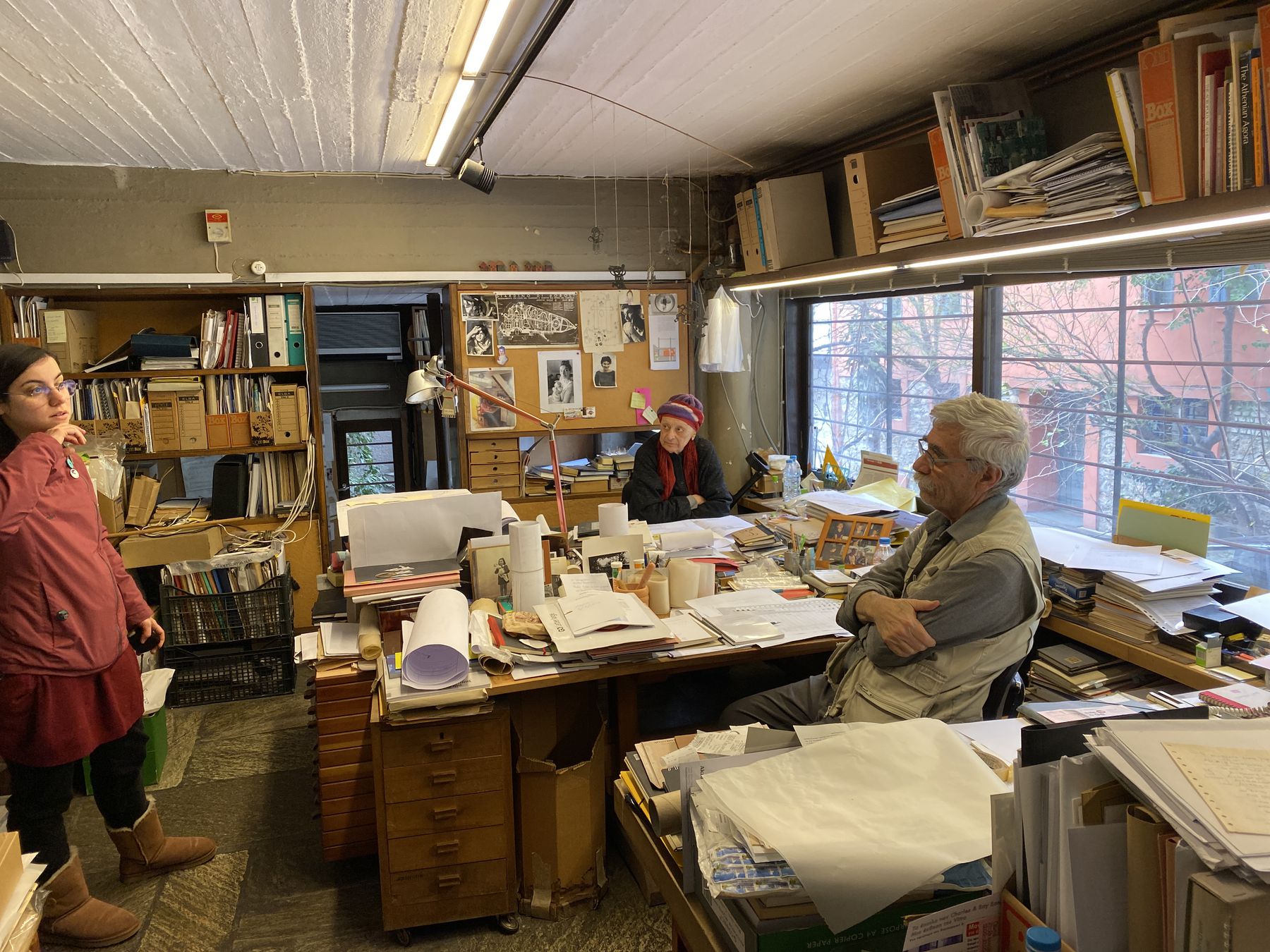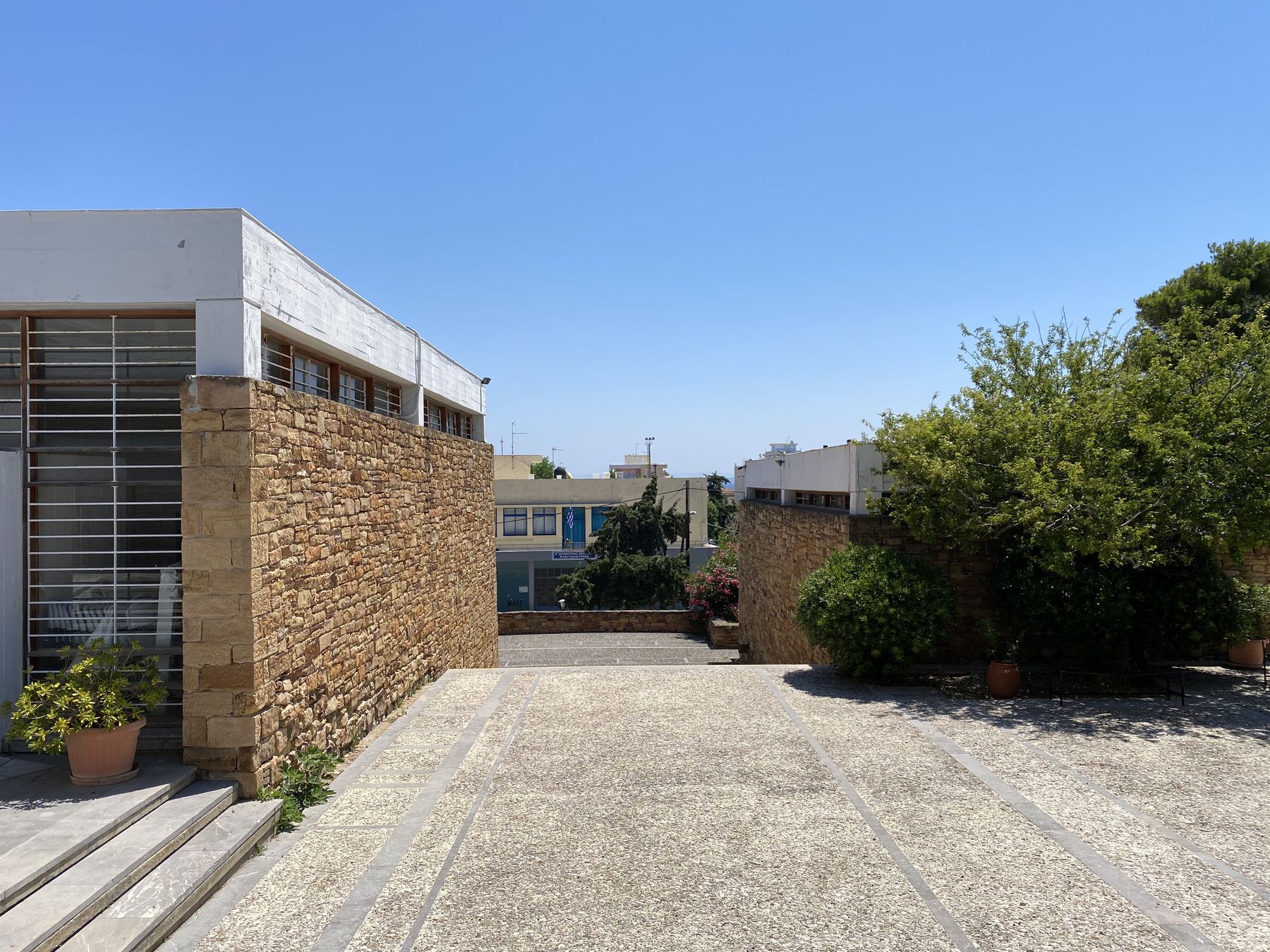Migration, Briefly Arrested: Revisiting Atelier 66
Claire Zimmerman reflects on Greece's situated modernism
In honor of Suzana Antonakakis (June 25,1935 - July 5, 2020)
”. . . boundaries shift from within; boundaries are very tricky.”1
Border contestations and disputes over ethnic identity periodically surface in the history of the Balkan peninsula, and of Greece in particular. Yet current crises bring them out in newly urgent ways. The island of Chios, site of the 1822 Ottoman massacre of Greeks made famous by French painter Eugène Delacroix, now houses one of the UN holding camps for those crossing the narrow channel from Turkey. It is also the site of one of many archaeological museums, built in Greece after World War II to support cultural development and a burgeoning tourist economy. As you approach the Chios Archaeological Museum (architects: Atelier 66, 1965), a white concrete frame appears tightly wrapped by rough masonry walls of a livid orange-hued stone quarried in nearby Thymiana, the same stone that lines the long narrow streets of the nearby Kampos. The reference could hardly be more direct: defensive walls around the estates of Genoese who took possession of Chiote land in the fourteenth century recall the island’s contested history here and around the nearby Mastichochoria, enclosed mastic-producing villages that date back hundreds of years. Protecting the museum’s contents, its walls also guide movement through the complex to the uphill side of the site. In the middle, an interior courtyard opens invitingly; there the building’s stone wrapper drops away and the interiors show themselves through glass screens stretched between concrete columns.2
-
Donna Haraway, “Situated Knowledges: The Science Question in Feminism and the Privilege of Partial Perspective,” Feminist Studies 14 (Autumn 1988): 3, 595. ↩
-
The Chios Archaeological Museum was subject to a substantial retrofit in the 1990s, without the architects’ input. The interior was gutted and partitioned and a garden court was enclosed. Other major changes to the building are still apparent, but it may be restored to its original state in future. My sincere thanks to Helen Paleodimou and Fragoula Tsairidou for their full tour of the facilities, including curatorial and storage spaces, in summer 2020. ↩
After an absence of twenty-five years, I had returned to Greece in 2019 to explore building in a centuries-long contested borderland. I lived briefly in a rooftop studio at Emmanuel Benaki 118 (EB 118), also the office of the architects of the Chios museum and the residence of two of the firm’s founding members, Suzana and Dimitri Antonakakis. When one arrives at the building, a gateway/portal at the street lets into an open circulation court in place of a lobby. From there, a corkscrew staircase climbs up the building at the very corner of the lot looking over Emmanuel Benaki Street, moving inside and then outside all the way up, along a balustrade grazing the street edge. The elevator lobby at the sixth floor is inside; the final flight moves outside once more. Even the studio interior seems only nominally enclosed: a window wall continuous with a broad skylight makes the inside of the studio feel like outside.
The building was designed by Atelier 66 in 1972. An architecture collective that was organized horizontally, the atelier grew during years of quietly defiant resistance among Greek intellectuals to the military junta of 1967-74. It became internationally known after 1981, when a pair of architect-critics discussed the firm’s work in terms of “how to become modern and to return to sources.”1 Atelier 66 inspires young Greek architects and historians today, and for good reason.2 The firm’s work is fundamentally situated, by Donna Haraway’s formulation: in relation to Greek history and culture; and in relation to techniques of architectural modernism deployed sensitively in the firm’s use of materials and spatial design. If traditional building has been claimed largely by the heritage industry, and modernism as a system of inflection (to climate, to region, to user) coopted by value engineers and volume production, how might these “utopian realists” craft a particularly Greek version of modern architecture, in productive disputation with the likes of Mies van der Rohe?3 And how does an architectural practice so rooted in a particular place also speak to human mobility—and indeed, to feminist architectural histories of migration?4
The work of A66 (as the firm was renamed after a reorganization that took place in 1987) reflects seemingly conflicting tendencies that actually fit well together, particularly considering Greek politics of the late 1960s. A modernist investigation of regional building patterns provided a compelling way to reject nationalist political claims, and to enact that rejection through architecture. Early in their careers, two of the founding principals made detailed case studies of typologies of regional building, one choosing the archontiko village of Makrinitsa, the other the island architecture of Hydra.5 That such historical typologies were areas of focus in the fifteen years after the end of WWII speaks to an especially fertile episode in the history of modern architecture, for which Greece had provided early touchstones, both in white cubic houses and in ancient polychrome temples bleached of color.6 One might well ask how Greek architects’ systematic research on local vernacular architectural traditions (linked to four centuries of Ottoman rule) relate to European projections of Greece both before and after the war, during which the country was again occupied, this time by fascist regimes from Italy, Germany, and Bulgaria.
-
L. Lefaivre and A. Tzonis, “The Grid and the Pathway,” Architecture in Greece 5 (1981), 164-178; K. Frampton, “Prospects for a Critical Regionalism,” Perspecta 20 (1983), 148-162. The quotation comes from Paul Ricœur. ↩
-
See Stelios Giamarelos, “Greece, the Modern Margin in the Classical Centre: Seven Points for Critical Regionalism as Historiography,” The Journal of Architecture, 25:8 (2020), 1055-1088, which appeared after this essay was already in press. Also see Nikolaos Magouliotis, “Learning from ‘Panosikoma’: Atelier 66’s Additions to Ordinary Houses,” Architectural Histories 6: 1 (2018), doi:10.5334/ah.299. ↩
-
Y. Tsiomis, untitled lecture from 2016: http://www.blod.gr/lectures/ Pages/viewlecture.aspx?LectureID=3219 (accessed July 25, 2020). ↩
-
Donna Haraway’s emphasis on embodied vision, mobility, and border zones resonate with the design techniques of A66: “. . . local knowledges have also to be in tension with the productive structurings that force unequal translations and exchanges—material and semiotic—within the webs of knowledge and power. Webs can have the property of being systematic, even of being centrally structured global systems with deep filaments and tenacious tendrils into time, space, and consciousness, which are the dimension of world history.” Haraway, “Situated Knowledges,” 588. The Of Migration issue exists as one installment of a multi-sited project: see Anooradha Iyer Siddiqi and Rachel Lee, “On Margins: Feminist Architectural Histories of Migration,” ABE Journal 16 (2019), http://journals.openedition.org.proxy.lib.umich.edu/abe/7126 (accessed January 7, 2022); and idem, “On Collaboration,” Aggregate, http://we-aggregate.org/project/on-collaborations-feminist-architectural-histories-of-migration (accessed January 7, 2022). ↩
-
Here their interests joined similar investigations to document and analyze regional domestic architecture closely related to migratory Balkan and Turkish domestic buildings, but also indigenous types like the Cycladic house. See A. Konstantinidis, Ta Palaia athinaika spitia (Athens, 1950); G. Megas, The Greek House and its Relation to the Houses of other Balkan States (Athens, 1951); P.A. Michelis, To Elliniko Laiko Spiti (Athens, 1960). ↩
-
During the same period, English architects investigated industrial vernacular. See J.M. Richards, The Functional Tradition in Early Industrial Building (London, 1958). Investigations of global vernacular building also flourished at this time, some grounded in the U.S., in the work of Bernard Rudofsky, Sibyl Moholy-Nagy, and J.B. Jackson. ↩
Commitments to European modernism have a special irony in Greece, where Greek vernacular forms as well as the country’s ancient past made it a locus classicus for European architects such as Schinkel and Soane. After the 1821 revolution, in an act of appropriation represented as a mythical “return,” planners laid out the centre of Athens with large neoclassical buildings by European architects.1 Yet the German and British appropriation of Greece didn’t begin with the Revolution or with Lord Byron’s travels in the early nineteenth century. “Europe” has long authorized itself using Greek antiquity, according the country honorary status as a wellspring for idealist thought.2 One of the earliest travelers from Europe to Greece to admire its antiquities and publicize them for his own countrymen was Cyriacus of Ancona, whose sketchbooks date to the mid-fifteenth century, long before Julien-David Le Roy, James Stuart, and Nicholas Revett filled their books with measured illustrations, predecessors of Frédéric Boissonnas’ storied Parthenon photographs in Towards an Architecture. There and elsewhere, prismatic, simplified, bleached architectural forms became core elements of international modern architecture and its photographic depiction.
Desiderata for twentieth century Greek architecture then seem to align with European modern movement principles—its centuries-long subjection to the Ottoman Empire evoking ideas of resistance and protest.3 Greece has been a border zone, site of interest, and diplomatic pawn between Europe and points eastward since the Persian Empire invaded in the fifth century BCE; parts of Greece were Turkish until 1912. A decade later, the so-called “Great Idea” (Megali Idea) for the Greek recapture of Constantinople/Istanbul underwritten by European powers failed completely, and resulted in an exchange of populations between the western coast of Anatolia and Greek cities, a colossal episode of violent dispossession and a blueprint for European politics of partition and ethnic cleansing that would come to define a century riven by world war.4 Modern Greek architects positioned themselves in light of such historical realities, that either fed or starved nationalist myths, depending on your point of view.5
-
Y. Tsiomis, Athènes à soi-même étrangère: naissance d’une capitale néoclassique (Marseilles: Parenthèses, 2017); A. Mirkovic, “Who Owns Athens? Urban Planning and the Struggle for Identity in Neo-Classical Athens (1832-1843),” Cuadernos de Historia Contemporánea 34 (2012), 147-158; E. Bastea, The Creation of Modern Athens: Planning the Myth (Cambridge, 2000). ↩
-
In philological studies, this included virtually ignoring Islamic scholars who preserved, transcribed, and inflected ancient texts that would otherwise have vanished from the historical record. ↩
-
See, for example, M. Georgopoulou, K. Thanasakis, Ottoman Athens: Archaeology, Topography, History (Athens, 2019). ↩
-
Today, a look at the newspaper dispels any doubt about the margin that is Greece. Border zones on Greek islands and near the River Evros, open to refugees throughout many years of recent crisis recently closed their doors as the government of Turkish President Recep Tayyip Erdoğan allowed more and more people to travel westward, angry with European countries which neither admit Turkey to the EU nor honor past financial commitments. Greece, caught again between two entities with little concern for its current capacities, is buffeted by powerful neighbors. ↩
-
R. Beaton and D. Ricks, The Making of Modern Greece: Nationalism, Romanticism & the Uses of the Past (1797-1896) (London, 2009). ↩
Atelier 66 was a collective in which partners assisted each other and staffed projects cooperatively as they came into the office. It particularly explored design in reinforced concrete that was painted or stuccoed. Among Greek modernists, the atelier affiliated itself with Dimitris Pikionis more than the international planner and developmentalist Constantine Doxiadis; their teacher was A. James Speyer, himself a student of Mies in Chicago.1 Buildings by A66 are zoned by patterns, demarcating spatial difference in the diagram; pathways through them trace intricate labyrinths; vertical organization is crucial. EB 118 is a case in point: the vertical circulation makes one conscious of inside-outside distinctions while moving through the liminal zone that sits inside the building, but outside the dwelling. The office downstairs is also arranged sectionally: a low reception area leads up and into the double height drafting room; stairs climb from there to ensuite workspaces and up further past a library wall of books and publications through which glimpses back and forwards appear; finally, the main design studio overlooks the drafting room on one side, and the street on the other. The “pathways” celebrated in the work of A66 were actually the ends in and of design, more than vectors of final destinations.2 The process of moving through, not the moment of arrival, is the focus; ambiguous patterns and circuitous movements turn back goal-oriented modernist devices (la promenade architecturale) with something like their opposite number, in architectural terms. Jean-Louis Cohen sees this as a fundamentally urbanistic commitment, executed at an architectural scale, in his reflection on the work of A66, which he calls “Mediterranean Brutalism.”3 Does urbanism invaginated in buildings suggest how community pervades society at all scales? This seems an accurate reflection of the notion of community that one encounters frequently throughout Greece.
The houses of Makrinitsa that Suzana Antonakakis studied painstakingly are zoned from bottom to top: storage and animals on the ground; winter quarters next, with thick walls, small windows, and cooking facilities; summer quarters on top with porches, verandas, and many windows, like an eagle’s nest. Three buildings are laid one atop another. Here, architecture shapes temporal patterns of use inflected by climate: warm in winter and cool in summer down below, breezy above for hot summer weather with air circulating in “chimneys” that move up stairwells. This simple device is an environmental achievement. In counterpoint, an international building system such as modern reinforced concrete frame construction could only compensate a country with limited resources for the loss of such highly specific local building patterns, if modernism could be retrofitted to accommodate the situated knowledge that they represent. Le Corbusier’s ubiquitous Domino diagram, the reification of such construction, represents the system; Atelier 66 provided the retrofit.
A moving analysis by Aristide Antonas (son of two of the founders) describes the firm’s work as motivated by “error.” Architectural ideas that seemed to the designers to be particularly well suited for a given commission might nonetheless accommodate conventional architectural parameters such as program, budget, code, and material availability only with difficulty. In the necessary architectural workarounds that follow, Antonas points out, lies the A66 project.4 In opposition to the smooth functioning of the architectural production machine, a commitment to the signal noise of architecture itself resonates particularly with their approach to international modernism after World War II. Like Aris Konstantinidis, A66 contested modernity’s reductions and elisions. Konstantinidis noted, in 1987: “Greece. . .which is situated between East and West, has a vernacular architectural tradition that is replete with quality and artistic restraint.”5 The error that threatens is simply modernization itself, imposing upon a long and much-tested geographical tradition the optimizations of a fundamentally abstract market economy.6
-
See the Antonakakis’s contributions to A. James Speyer: Architect, Curator, Exhibition Designer (Chicago:, 1997). ↩
-
“. . .it was the very act of travelling—rather than the celebrated exhibition—that reinforced their architectural sensibility.” S. Giamarelos, “Intersecting Itineraries Beyond the Strada Novissima: The Converging Authorship of Critical Regionalism,” Architectural Histories 4 (2016):1, 1-18. DOI: http://dx.doi.org/10.5334/ah.192 ↩
-
J.-L. Cohen, “The Mediterranean Brutalism of Demetris and Susanna Antonakakis,” Place and Architecture, The French Institute of Athens, 15th April 1994. ↩
-
A. Antonas, Forum: “Error and Recovery,” Nordisk Arkitekturforskning 3 (1999) 1-7. ↩
-
A. Konstantinidis, Amartoli kai kleftes i i apoyeosi tis architektonikis (Athina, 1987), 25, as cited in E. Fessas-Emmanouil, Essays on Neohellenic Architecture (Athens, 2001), 100. ↩
-
Left-critics of the interwar years such as Max Raphael, Siegfried Kracauer, and Adolf Behne called out international modernism for mandates of profit smuggled in under the rubric of development. Left thinkers in postwar Greece mounted a similar critique. ↩
During a quiet moment in July 2020, I sit in the museum’s courtyard, which is empty of visitors. Few have come to Chios this year. The tourist economy has been recently shaken by the COVID-19 pandemic that threatens the very possibility of its future. On this day, a group approaches, wending back and forth up the pathway from the street—a choreography that conjures the Panathenaic way or a village street in the Mastichochoria. I hear Arabic spoken and infer that these visitors may have come from Vila, the refugee camp near Thymiana. If the archaeological museum enacts one form of philoxenia (love of strangers, or hospitality), the refugee camp implies another. Camp and museum are thresholds for those entering Greece: one grounds building in the long history of a place, narrating it to visitors; the other temporarily shelters those recently re-designated by international authorities from “doctor” or “sister” to “refugee.” Tourists and refugees are radically different kinds of guests; at this moment only the latter seems likely to pass through the ports of Chios, and even that has changed in recent months.1 The visitors enter the museum to survey remnants of the Hellenistic past, part of the history of Greco-Roman colonization that sent forces well beyond Palmyra into Bactria (present-day Afghanistan). The museum’s welcoming emptiness and the curiosity of refugees come into momentary proximity, as the situated modernism of Greece meets its latest human witnesses.
-
InfoMigrants, “Migration: Fewer people arrived on Greek Islands in 2021,” January 7, 2022, https://www.infomigrants.net/en/post/37717/migration-fewer-people-arrived-on-greek-islands-in-2021. ↩
